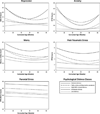Patterns of psychological distress in mothers of preterm infants
- PMID: 26495909
- PMCID: PMC4654120
- DOI: 10.1016/j.infbeh.2015.10.004
Patterns of psychological distress in mothers of preterm infants
Abstract
Mothers of preterm infants experience significant psychological distress, with elevated levels of inter-correlated depressive, stress, anxiety and post-traumatic stress symptoms. In a sample of racially and ethnically diverse mothers of preterm infants, we identified differing patterns of psychological distress during infant hospitalization and examined the effect of these psychological distress patterns on longitudinal trajectories of each psychological distress measure and on maternal perceptions of the child over the first year of the infant's life. Mothers of preterm infants (N=232) completed five questionnaires assessing depressive symptoms, anxiety, post-traumatic stress symptoms, stress due to infant appearance, and stress due to parental role alteration during enrollment during the neonatal hospitalization, discharge, and at 2, 6, and 12 months of age adjusted for prematurity. Latent class analysis on the enrollment psychological distress variables allowed us to identify five sub-groups of mothers exhibiting similar patterns of psychological distress, differing primarily in degree and type: low distress, moderate distress, high NICU-related distress, high depressive and anxiety symptoms, and extreme distress. These classes continued to show different longitudinal trajectories for the psychological distress measures through 12 months corrected age. Mothers in the extreme distress class and, to a lesser degree, mothers in the high depressive and anxiety symptom class remained at risk of significant psychological distress one year after discharge and had less positive perceptions of their child (greater worry and higher perceptions of child vulnerability). In conclusion, distinctive sub-groups of mothers during hospitalization had different patterns of psychological distress throughout the 12-month period and may require different interventions in the NICU.
Keywords: Anxiety; Depression; Maternal psychological distress; Prematurity; Stress.
Copyright © 2015 Elsevier Inc. All rights reserved.
Conflict of interest statement
The authors declared no potential conflicts of interest with respect to the research, authorship, and/or publication of this article.
Figures
Similar articles
-
Patterns of distress in African-American mothers of preterm infants.J Dev Behav Pediatr. 2009 Jun;30(3):193-205. doi: 10.1097/DBP.0b013e3181a7ee53. J Dev Behav Pediatr. 2009. PMID: 19412125 Free PMC article.
-
Relationship of Maternal Psychological Distress Classes to Later Mother-Infant Interaction, Home Environment, and Infant Development in Preterm Infants.Res Nurs Health. 2016 Jun;39(3):175-86. doi: 10.1002/nur.21719. Epub 2016 Apr 5. Res Nurs Health. 2016. PMID: 27059608 Free PMC article.
-
Depression, anxiety, and perinatal-specific posttraumatic distress in mothers of very low birth weight infants in the neonatal intensive care unit.J Dev Behav Pediatr. 2015 Jun;36(5):362-70. doi: 10.1097/DBP.0000000000000174. J Dev Behav Pediatr. 2015. PMID: 26039191 Free PMC article.
-
The effect of cognitive-behavioral therapy on psychological distress in the mothers of preterm infants: a systematic review and meta-analysis.J Psychosom Obstet Gynaecol. 2020 Sep;41(3):167-176. doi: 10.1080/0167482X.2019.1678019. Epub 2019 Oct 16. J Psychosom Obstet Gynaecol. 2020. PMID: 31619096
-
An integrative review of maternal distress during neonatal intensive care hospitalization.Arch Womens Ment Health. 2021 Apr;24(2):217-229. doi: 10.1007/s00737-020-01063-7. Epub 2020 Aug 27. Arch Womens Ment Health. 2021. PMID: 32851469 Review.
Cited by
-
Incidence and Predictors of Mortality Among Preterm Neonates Admitted to Jimma University Medical Center, Southwest Ethiopia: a Retrospective Follow-Up Study.Int J Public Health. 2024 Jul 4;69:1606897. doi: 10.3389/ijph.2024.1606897. eCollection 2024. Int J Public Health. 2024. PMID: 39027016 Free PMC article.
-
Effect of family-centred care on parental mental health and parent-infant interactions for preterm infants: a systematic review protocol.BMJ Open. 2022 Oct 5;12(10):e062004. doi: 10.1136/bmjopen-2022-062004. BMJ Open. 2022. PMID: 36198456 Free PMC article.
-
[Preterm birth: a risk for mental health?].Psychotherapeut (Berl). 2022;67(1):28-33. doi: 10.1007/s00278-021-00552-z. Epub 2021 Oct 31. Psychotherapeut (Berl). 2022. PMID: 34744317 Free PMC article. Review. German.
-
Evaluation of a course for neonatal fellows on providing psychosocial support to NICU families.PEC Innov. 2022 May 25;1:100053. doi: 10.1016/j.pecinn.2022.100053. eCollection 2022 Dec. PEC Innov. 2022. PMID: 37213727 Free PMC article.
-
Prevalence of anxiety, depression, and stress among parents of neonates admitted to neonatal intensive care unit: a systematic review and meta-analysis.Clin Exp Pediatr. 2024 Feb;67(2):104-115. doi: 10.3345/cep.2023.00486. Epub 2023 Nov 14. Clin Exp Pediatr. 2024. PMID: 37986569 Free PMC article.
References
-
- WHO. Born too soon: The global action report on preterm birth. Geneva: 2012.
-
- Jubinville J, Newburn-Cook C, Hegadoren K, Lacaze-Masmonteil T. Symptoms of acute stress disorder in mothers of premature infants. Adv Neonatal Care. 2012;12(4):246–253. - PubMed
Publication types
MeSH terms
Grants and funding
LinkOut - more resources
Full Text Sources
Other Literature Sources
Medical


